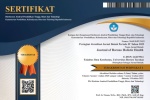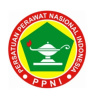Happy Hypoxemia Pada Covid-19
Abstract
World Health Organization (WHO) telah menyatakan bahwa COVID-19  sebagai masalah kesehatan dunia. Pada Februari 2020, sebanyak total 81.109 kasus terkonfirmasi. SARS-CoV-2 semakin menjadi tantangan bagi tenaga medis dikarenakan oleh presentasi klinis yang bervariasi, salah satunya adalah silent atau happy hypoxemia. Pasien mengalami hipoksemia berat tanpa dyspnea. Dewasa ini, happy hipoxemia merupakan salah satu gejala COVID-19 yang baru-baru ini diketahui. Studi literatur ini bertujuan untuk mempelajari kepentingan “happy hypoxemia†pada COVID-19. COVID-19 dapat menyebabkan hipoksemia disebut sebagai “silent†atau “happy hypoxemiaâ€, yang merupakan gejala yang tidak khas. Pasien yang mengalami happy hypoxemia dapat jatuh ke dalam hipoksemia berat tanpa disertai dyspnea dan dengan compliance paru yang mendekati normal, serta tidak ada tatalaksana khusus. Beberapa hipotesis terjadinya happy hypoxemia; barrier alur oksigen alveoli, microthrombi intravascular, rute neural ataupun gangguan dari mekanisme hypoxic pulmonary vasoconstriction. Hal ini dapat menyebabkan gangguan perfusi organ, karena tanpa adanya gejala dyspnea dapat mengakibatkan kondisi iskemik terus berlanjut menjadi kritis tanpa disertai suatu peringatan awal. Sehingga sangat penting monitoring rutin dari saturasi oksigen dan suplementasi oksigen sesuai indikasi pada pasien COVID-19.
Keywords
Full Text:
PDF (Bahasa Indonesia)References
Anoop U.R., Verna K. Happy Hypoxemia in
COVID19- A Neural Hypothesis. ACS ChemNeurosci. 2020;11(13). DOI: 10.1021/acschemneuro.0c00318.
Broqui P, Amrane S, Million M, Cortaredona
S, Patola P, Lagier J.C., et al. Asymptomatic hypoxia in COVID-19 is associated with poor outcome. International Journal of Infectiious Disease. 2020. DOI: https://doi.org/10.1016/j.ijid.2020.10.067.
Chandra A, Chakraborty U, Pal J, Karmakar
P. Silent Hypoxia: a frequently overlooked clinical entity in patients with COVID-19. BMJ Journals. 2020. DOI: http://dx.doi.org/10.1136/bcr-2020-237207
Curbelo C.M. Silent or ‘Happy’ Hypoxemia:
An Urget Dilemma for COVID-19 Patient Care. Scielo Public Health. 2020. DOI: https://doi.org/10.37757/MR2020.V22.N4.9.
Dhont S, Derom E, Braeckel E.V., Depuyt P,
Lambrecht B.N. The pathophysiology of ‘happy’ hypoxemia in COVID-19. Respiratory Research. 2020(198).
Duarte A.G. Kaufmann L.N. Is ‘happy
hypoxia’ in COVID-19 a disorder of autonomic interoception?Clinical Autonomic Research. 2020. DOI: https://doi.org/10.1007/s10286-020-00715-z.
Frankel J.C. The mystery of the pandemic’s
‘happy hypoxia’.SCIENCE.2020;Vol 368.DOI:10.1126/science.368.6490.455
Fuglebjerg N.J.U. Jensen T.O., Hoyer N.
Ryrso C.K., Lindegard B., Harbooe Z.B. Silent hypoxia in patients with SARS CoV-2 infection before hospital discharge. International Journal of Infectious Disease. 2020. DOI: https://doi.org/10.1016/j.ijid.2020.07.014 .
Guan W, Ni Z, Hu Y, Liang W, Ou C, He J, et
al. Clinical Characteristics of Coronavirus. NEJM. 2020. DOI: 10.1056/NEJMoa2002032.
Haryalchi K, Heidarzadeh A, Abedinzade M,
Tehrani S.O, Tehran S.G. The Importance of Happy Hypoxemia in COVID-19. Anesthesiology and Pain Medicine. 2021. DOI : 10.5812/aapm.111872
Helmy Y.A., Fawzy M, Elaswad A, Sobieh A,
Kenney S.P., Shehata A.A. The COVID-19 Pandemic: A Comprehensive Review of Taxonomy, Genetics, Epidemiology, Diagnosis, Treatment, and Control. J Clin Med. 2020. doi: 10.3390/jcm9041225.
Li L.Q., Huang T., Wang Y.Q.,Wang Z.P.,
Liang Y, Huang T.B., et al. COVID-19 patients clinical characteristics, discharge rate, and fatality rate of meta analysis. J Med Virol. 2020. DOI: 10.1002/jmv.25757.
Li Y.C., Bai W.Z., Hashikawa T. The
neuroinvasive potential of SARS-COV2 may play a role in the respiratory failure of COVID-19 patients. J Med Virol. 2020. DOI: 10.1002/jmv.25728.
Paton J.F.R., Felippe I. Paterson D.J.,
Donnelly J. Lessons from integrated systems physiology. The Physiologycal Society. May 2020.
Recasens B.B., Llorens J.M.M., Sevilla J.J.R.,
Rubio M.A. Lack of dyspnea in patients with COVID-19: another neurological conundrum?. Eur J Neurol. 2020. DOI: 10.1111/ene.14265
Sun P, Lu X, Xu C, Sun W, Pan B.
Understanding of COVID-19 based on current evidence. J Med Virol. 2020. doi: 10.1002/jmv.25722.
Swenson K.E. Ruoss S.J.Swenson E.R. The
Pathophysiology and Dangers of Silent Hypoxemia in COVID-19 Lung Injury. Annals ATS. 2021. Vol 18. DOI: 10.1513/AnnalsATS.202011-1376CME.
Tobin M.J., Laghi F, Jubran A. Why COVID-
Silent Hypoxemia is Baffling to Physicians. Pubmed. 2020. DOI: 10.1164/rccm.202006-2157CP
Wilkerson R.G., Adler J.D., Shah N.G., Brown
R. Silent hypoxia: A harbinger of clinical deterioration in patients with COVID-19. Am J Emerg Med. 2020. doi: 10.1016/j.ajem.2020.05.044. Epub 2020 May 22.
DOI: https://doi.org/10.35334/borticalth.v4i2.2098
Refbacks
- There are currently no refbacks.









